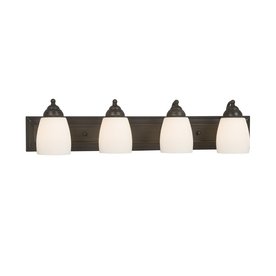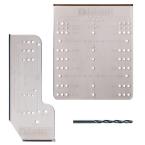Since I'm new to this whole, "do-it-yourself" thing I should know everything isn't going to work out perfectly. We ran into some difficulties when trying to install a new light fixture in the guest bathroom. The light in the bathroom was brushed nickel and all the other fixtures (besides the faucet) is oil-rubbed bronze (orb). Plenty-a-time was spent online shopping for a new fixture since there were some specific issues we had to navigate. I did not want to re-paint the bathroom right now so to make it easy we went with a light fixture with a long back plate.

Inexpensive, large enough to cover where the old light fixture was and the right color...right? right???
Well here is where we ran into a problem. You see where the wires are suppose to go on the back plate?
 |
Well whoever added the bathroom onto our house did some funky wiring. They cut a hole on the right side of the plate and ran wires from the fixture over to the wall wires. We didn't have the tools to cut through metal and we couldn't re-use the existing back plate because it was too small for the new fixture. What were we to do? Such a first world problem huh? Well fortunately there is a magic spray to make everything all better.
Rustoleum All-Surface paint in oil rubbed bronze. I spray painted the existing brushed nickel fixture. We exchanged the light fixture we bought and got new one for the upstairs guest bath (will post soon on that bathroom re-do). I've never actually spray painted anything until the other day. Here's how I did it after the hubs took down the fixture:
**Turn off the breaker prior to working with electrical wires**
 |
| You can see why we had to use a fixture with a long back plate- to cover the paint or lack thereof. |
Step One: Tape the ground wire (the copper looking wire) up with some electrical tape to protect it.
Step Two: Clean off fixture with a damp washcloth.
Step Three: Using 400 grit sandpaper, sand down all metal surfaces. Do not use any other grit of sandpaper! It will be too rough on the metal surface. The sandpaper helps to rough up the surface so the paint can stick to it.
Step Four: Wipe off with dry washcloth.
Step Five: Lay out fixture on a drop cloth (old tablecloth, plastic sheet, broken down cardboard box) in a well ventilated area. I laid everything out in my garage and opened the garage door.
Step Six: Shake can of paint well and follow directions on the can. It basically says to hold the can 8-12 inches away from whatever you are spray painting, spray continuously one light coat. Wait a few minutes and spray a second light coat. Orb-ing orb-ing orb-ing...
Wait at least 24 hours to let dry and then re-install. I had the hubs help me with this part due to some electrical wiring I was not comfortable doing. However, I'm sure I can do it by myself now.
Here is the finished product. I forgot to take a "before" picture as I'm still new to this blogging thing. But just imagine this same fixture in brushed nickel. I'm pretty happy with how this turned out. Total cost of this project= less than $10.00! That sure beats buying a new light fixture!




























.JPG)

